Effectiveness of EU Directives: A European Constitutional Law Report
VerifiedAdded on 2021/02/19
|7
|2015
|46
Report
AI Summary
This report delves into the challenges of invoking EU directives against individuals, focusing on the landmark case of Marshall v Southampton. It explores the limitations of the 'emanation of the state' and the doctrine of indirect effect in providing effective remedies. The report analyzes the direct effect principle, horizontal direct effect, and the conditions under which directives can be applied. It examines how the European Court of Justice (ECJ) has addressed the issue, including the introduction of the 'Foster test' and the principle of interpretation. The report concludes that neither the development of the concept of the ‘emanation of the state’ nor the introduction of the doctrine of indirect effect provides an appropriate and effective solution when an individual wishes to invoke a directive against another individual, highlighting the need for clearer legal provisions to protect individual rights within the framework of European Constitutional Law. The report also references several academic sources that have been used for research.
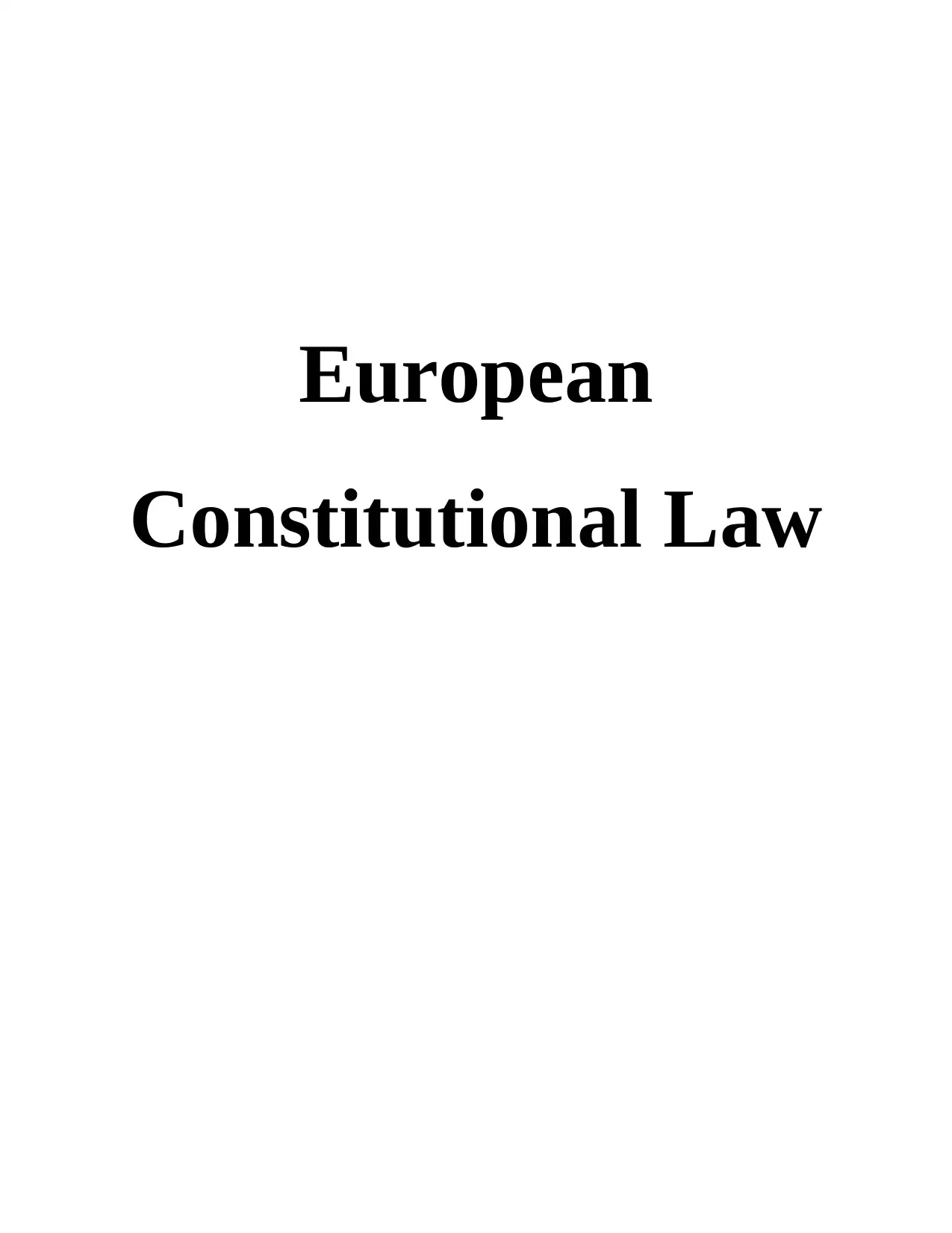
European
Constitutional Law
Constitutional Law
Paraphrase This Document
Need a fresh take? Get an instant paraphrase of this document with our AI Paraphraser

Table of Contents
INTRODUCTION...........................................................................................................................3
MAIN BODY...................................................................................................................................3
CONCLUSION................................................................................................................................6
REFERENCES................................................................................................................................7
INTRODUCTION...........................................................................................................................3
MAIN BODY...................................................................................................................................3
CONCLUSION................................................................................................................................6
REFERENCES................................................................................................................................7
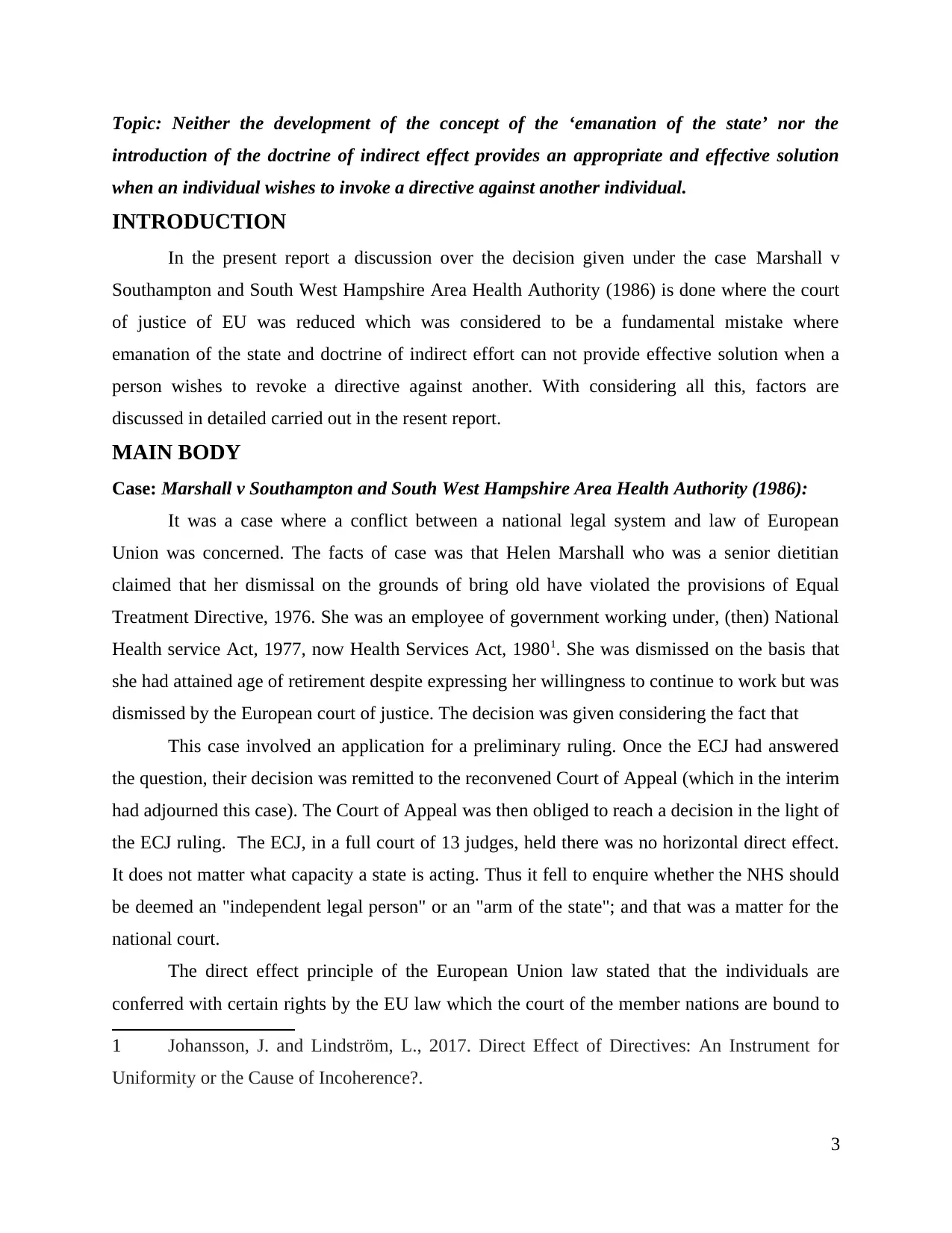
Topic: Neither the development of the concept of the ‘emanation of the state’ nor the
introduction of the doctrine of indirect effect provides an appropriate and effective solution
when an individual wishes to invoke a directive against another individual.
INTRODUCTION
In the present report a discussion over the decision given under the case Marshall v
Southampton and South West Hampshire Area Health Authority (1986) is done where the court
of justice of EU was reduced which was considered to be a fundamental mistake where
emanation of the state and doctrine of indirect effort can not provide effective solution when a
person wishes to revoke a directive against another. With considering all this, factors are
discussed in detailed carried out in the resent report.
MAIN BODY
Case: Marshall v Southampton and South West Hampshire Area Health Authority (1986):
It was a case where a conflict between a national legal system and law of European
Union was concerned. The facts of case was that Helen Marshall who was a senior dietitian
claimed that her dismissal on the grounds of bring old have violated the provisions of Equal
Treatment Directive, 1976. She was an employee of government working under, (then) National
Health service Act, 1977, now Health Services Act, 19801. She was dismissed on the basis that
she had attained age of retirement despite expressing her willingness to continue to work but was
dismissed by the European court of justice. The decision was given considering the fact that
This case involved an application for a preliminary ruling. Once the ECJ had answered
the question, their decision was remitted to the reconvened Court of Appeal (which in the interim
had adjourned this case). The Court of Appeal was then obliged to reach a decision in the light of
the ECJ ruling. The ECJ, in a full court of 13 judges, held there was no horizontal direct effect.
It does not matter what capacity a state is acting. Thus it fell to enquire whether the NHS should
be deemed an "independent legal person" or an "arm of the state"; and that was a matter for the
national court.
The direct effect principle of the European Union law stated that the individuals are
conferred with certain rights by the EU law which the court of the member nations are bound to
1 Johansson, J. and Lindström, L., 2017. Direct Effect of Directives: An Instrument for
Uniformity or the Cause of Incoherence?.
3
introduction of the doctrine of indirect effect provides an appropriate and effective solution
when an individual wishes to invoke a directive against another individual.
INTRODUCTION
In the present report a discussion over the decision given under the case Marshall v
Southampton and South West Hampshire Area Health Authority (1986) is done where the court
of justice of EU was reduced which was considered to be a fundamental mistake where
emanation of the state and doctrine of indirect effort can not provide effective solution when a
person wishes to revoke a directive against another. With considering all this, factors are
discussed in detailed carried out in the resent report.
MAIN BODY
Case: Marshall v Southampton and South West Hampshire Area Health Authority (1986):
It was a case where a conflict between a national legal system and law of European
Union was concerned. The facts of case was that Helen Marshall who was a senior dietitian
claimed that her dismissal on the grounds of bring old have violated the provisions of Equal
Treatment Directive, 1976. She was an employee of government working under, (then) National
Health service Act, 1977, now Health Services Act, 19801. She was dismissed on the basis that
she had attained age of retirement despite expressing her willingness to continue to work but was
dismissed by the European court of justice. The decision was given considering the fact that
This case involved an application for a preliminary ruling. Once the ECJ had answered
the question, their decision was remitted to the reconvened Court of Appeal (which in the interim
had adjourned this case). The Court of Appeal was then obliged to reach a decision in the light of
the ECJ ruling. The ECJ, in a full court of 13 judges, held there was no horizontal direct effect.
It does not matter what capacity a state is acting. Thus it fell to enquire whether the NHS should
be deemed an "independent legal person" or an "arm of the state"; and that was a matter for the
national court.
The direct effect principle of the European Union law stated that the individuals are
conferred with certain rights by the EU law which the court of the member nations are bound to
1 Johansson, J. and Lindström, L., 2017. Direct Effect of Directives: An Instrument for
Uniformity or the Cause of Incoherence?.
3
⊘ This is a preview!⊘
Do you want full access?
Subscribe today to unlock all pages.

Trusted by 1+ million students worldwide
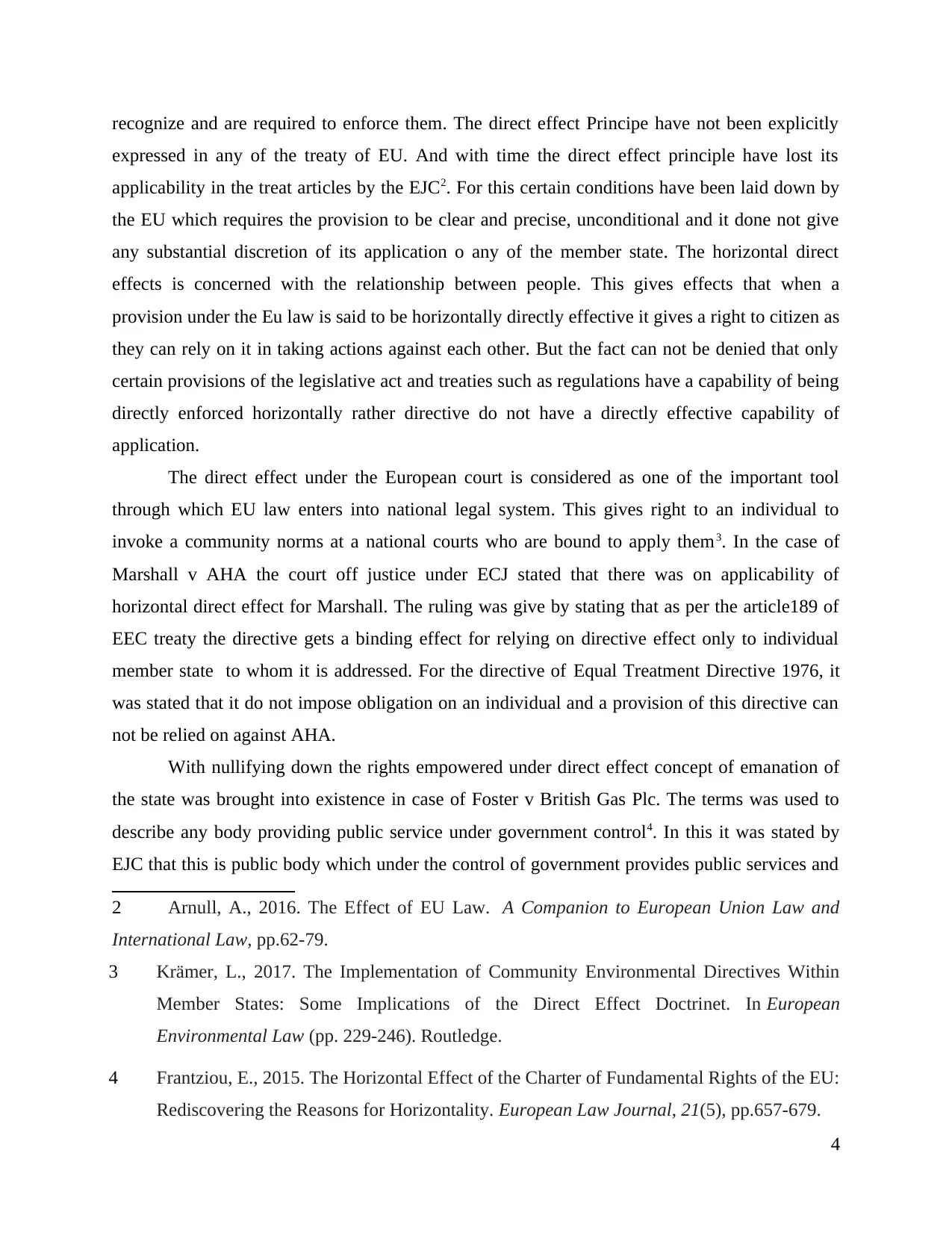
recognize and are required to enforce them. The direct effect Principe have not been explicitly
expressed in any of the treaty of EU. And with time the direct effect principle have lost its
applicability in the treat articles by the EJC2. For this certain conditions have been laid down by
the EU which requires the provision to be clear and precise, unconditional and it done not give
any substantial discretion of its application o any of the member state. The horizontal direct
effects is concerned with the relationship between people. This gives effects that when a
provision under the Eu law is said to be horizontally directly effective it gives a right to citizen as
they can rely on it in taking actions against each other. But the fact can not be denied that only
certain provisions of the legislative act and treaties such as regulations have a capability of being
directly enforced horizontally rather directive do not have a directly effective capability of
application.
The direct effect under the European court is considered as one of the important tool
through which EU law enters into national legal system. This gives right to an individual to
invoke a community norms at a national courts who are bound to apply them3. In the case of
Marshall v AHA the court off justice under ECJ stated that there was on applicability of
horizontal direct effect for Marshall. The ruling was give by stating that as per the article189 of
EEC treaty the directive gets a binding effect for relying on directive effect only to individual
member state to whom it is addressed. For the directive of Equal Treatment Directive 1976, it
was stated that it do not impose obligation on an individual and a provision of this directive can
not be relied on against AHA.
With nullifying down the rights empowered under direct effect concept of emanation of
the state was brought into existence in case of Foster v British Gas Plc. The terms was used to
describe any body providing public service under government control4. In this it was stated by
EJC that this is public body which under the control of government provides public services and
2 Arnull, A., 2016. The Effect of EU Law. A Companion to European Union Law and
International Law, pp.62-79.
3 Krämer, L., 2017. The Implementation of Community Environmental Directives Within
Member States: Some Implications of the Direct Effect Doctrinet. In European
Environmental Law (pp. 229-246). Routledge.
4 Frantziou, E., 2015. The Horizontal Effect of the Charter of Fundamental Rights of the EU:
Rediscovering the Reasons for Horizontality. European Law Journal, 21(5), pp.657-679.
4
expressed in any of the treaty of EU. And with time the direct effect principle have lost its
applicability in the treat articles by the EJC2. For this certain conditions have been laid down by
the EU which requires the provision to be clear and precise, unconditional and it done not give
any substantial discretion of its application o any of the member state. The horizontal direct
effects is concerned with the relationship between people. This gives effects that when a
provision under the Eu law is said to be horizontally directly effective it gives a right to citizen as
they can rely on it in taking actions against each other. But the fact can not be denied that only
certain provisions of the legislative act and treaties such as regulations have a capability of being
directly enforced horizontally rather directive do not have a directly effective capability of
application.
The direct effect under the European court is considered as one of the important tool
through which EU law enters into national legal system. This gives right to an individual to
invoke a community norms at a national courts who are bound to apply them3. In the case of
Marshall v AHA the court off justice under ECJ stated that there was on applicability of
horizontal direct effect for Marshall. The ruling was give by stating that as per the article189 of
EEC treaty the directive gets a binding effect for relying on directive effect only to individual
member state to whom it is addressed. For the directive of Equal Treatment Directive 1976, it
was stated that it do not impose obligation on an individual and a provision of this directive can
not be relied on against AHA.
With nullifying down the rights empowered under direct effect concept of emanation of
the state was brought into existence in case of Foster v British Gas Plc. The terms was used to
describe any body providing public service under government control4. In this it was stated by
EJC that this is public body which under the control of government provides public services and
2 Arnull, A., 2016. The Effect of EU Law. A Companion to European Union Law and
International Law, pp.62-79.
3 Krämer, L., 2017. The Implementation of Community Environmental Directives Within
Member States: Some Implications of the Direct Effect Doctrinet. In European
Environmental Law (pp. 229-246). Routledge.
4 Frantziou, E., 2015. The Horizontal Effect of the Charter of Fundamental Rights of the EU:
Rediscovering the Reasons for Horizontality. European Law Journal, 21(5), pp.657-679.
4
Paraphrase This Document
Need a fresh take? Get an instant paraphrase of this document with our AI Paraphraser
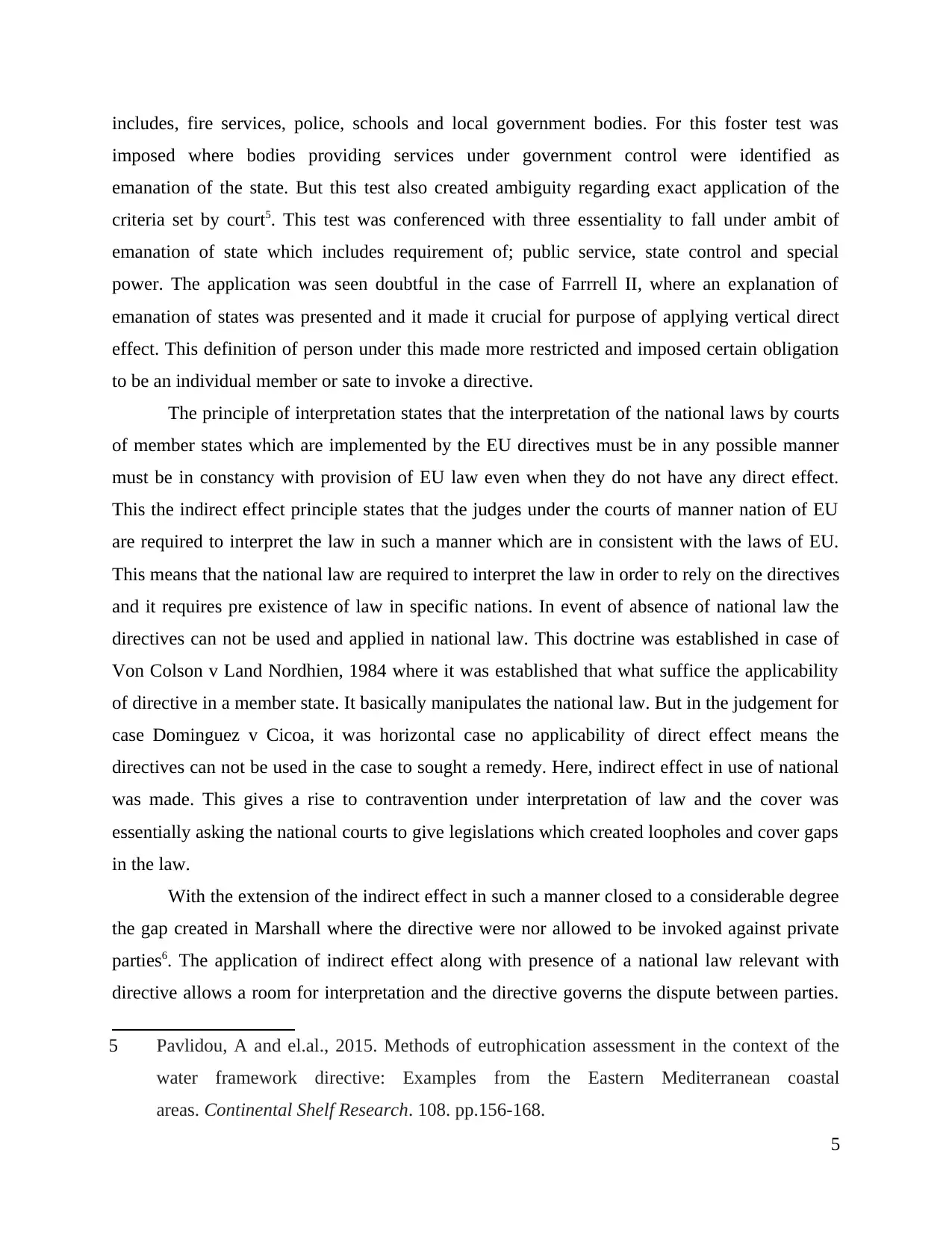
includes, fire services, police, schools and local government bodies. For this foster test was
imposed where bodies providing services under government control were identified as
emanation of the state. But this test also created ambiguity regarding exact application of the
criteria set by court5. This test was conferenced with three essentiality to fall under ambit of
emanation of state which includes requirement of; public service, state control and special
power. The application was seen doubtful in the case of Farrrell II, where an explanation of
emanation of states was presented and it made it crucial for purpose of applying vertical direct
effect. This definition of person under this made more restricted and imposed certain obligation
to be an individual member or sate to invoke a directive.
The principle of interpretation states that the interpretation of the national laws by courts
of member states which are implemented by the EU directives must be in any possible manner
must be in constancy with provision of EU law even when they do not have any direct effect.
This the indirect effect principle states that the judges under the courts of manner nation of EU
are required to interpret the law in such a manner which are in consistent with the laws of EU.
This means that the national law are required to interpret the law in order to rely on the directives
and it requires pre existence of law in specific nations. In event of absence of national law the
directives can not be used and applied in national law. This doctrine was established in case of
Von Colson v Land Nordhien, 1984 where it was established that what suffice the applicability
of directive in a member state. It basically manipulates the national law. But in the judgement for
case Dominguez v Cicoa, it was horizontal case no applicability of direct effect means the
directives can not be used in the case to sought a remedy. Here, indirect effect in use of national
was made. This gives a rise to contravention under interpretation of law and the cover was
essentially asking the national courts to give legislations which created loopholes and cover gaps
in the law.
With the extension of the indirect effect in such a manner closed to a considerable degree
the gap created in Marshall where the directive were nor allowed to be invoked against private
parties6. The application of indirect effect along with presence of a national law relevant with
directive allows a room for interpretation and the directive governs the dispute between parties.
5 Pavlidou, A and el.al., 2015. Methods of eutrophication assessment in the context of the
water framework directive: Examples from the Eastern Mediterranean coastal
areas. Continental Shelf Research. 108. pp.156-168.
5
imposed where bodies providing services under government control were identified as
emanation of the state. But this test also created ambiguity regarding exact application of the
criteria set by court5. This test was conferenced with three essentiality to fall under ambit of
emanation of state which includes requirement of; public service, state control and special
power. The application was seen doubtful in the case of Farrrell II, where an explanation of
emanation of states was presented and it made it crucial for purpose of applying vertical direct
effect. This definition of person under this made more restricted and imposed certain obligation
to be an individual member or sate to invoke a directive.
The principle of interpretation states that the interpretation of the national laws by courts
of member states which are implemented by the EU directives must be in any possible manner
must be in constancy with provision of EU law even when they do not have any direct effect.
This the indirect effect principle states that the judges under the courts of manner nation of EU
are required to interpret the law in such a manner which are in consistent with the laws of EU.
This means that the national law are required to interpret the law in order to rely on the directives
and it requires pre existence of law in specific nations. In event of absence of national law the
directives can not be used and applied in national law. This doctrine was established in case of
Von Colson v Land Nordhien, 1984 where it was established that what suffice the applicability
of directive in a member state. It basically manipulates the national law. But in the judgement for
case Dominguez v Cicoa, it was horizontal case no applicability of direct effect means the
directives can not be used in the case to sought a remedy. Here, indirect effect in use of national
was made. This gives a rise to contravention under interpretation of law and the cover was
essentially asking the national courts to give legislations which created loopholes and cover gaps
in the law.
With the extension of the indirect effect in such a manner closed to a considerable degree
the gap created in Marshall where the directive were nor allowed to be invoked against private
parties6. The application of indirect effect along with presence of a national law relevant with
directive allows a room for interpretation and the directive governs the dispute between parties.
5 Pavlidou, A and el.al., 2015. Methods of eutrophication assessment in the context of the
water framework directive: Examples from the Eastern Mediterranean coastal
areas. Continental Shelf Research. 108. pp.156-168.
5
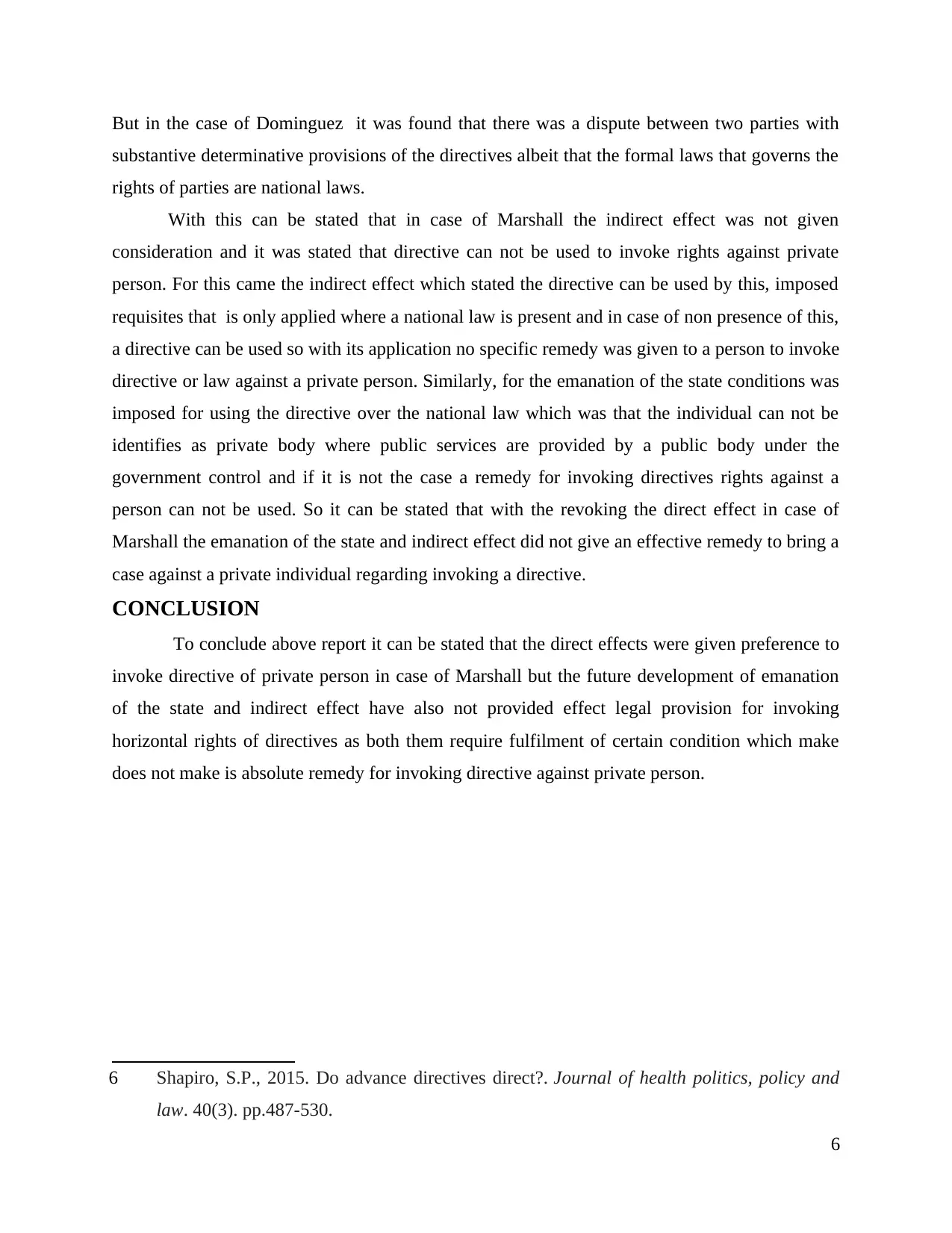
But in the case of Dominguez it was found that there was a dispute between two parties with
substantive determinative provisions of the directives albeit that the formal laws that governs the
rights of parties are national laws.
With this can be stated that in case of Marshall the indirect effect was not given
consideration and it was stated that directive can not be used to invoke rights against private
person. For this came the indirect effect which stated the directive can be used by this, imposed
requisites that is only applied where a national law is present and in case of non presence of this,
a directive can be used so with its application no specific remedy was given to a person to invoke
directive or law against a private person. Similarly, for the emanation of the state conditions was
imposed for using the directive over the national law which was that the individual can not be
identifies as private body where public services are provided by a public body under the
government control and if it is not the case a remedy for invoking directives rights against a
person can not be used. So it can be stated that with the revoking the direct effect in case of
Marshall the emanation of the state and indirect effect did not give an effective remedy to bring a
case against a private individual regarding invoking a directive.
CONCLUSION
To conclude above report it can be stated that the direct effects were given preference to
invoke directive of private person in case of Marshall but the future development of emanation
of the state and indirect effect have also not provided effect legal provision for invoking
horizontal rights of directives as both them require fulfilment of certain condition which make
does not make is absolute remedy for invoking directive against private person.
6 Shapiro, S.P., 2015. Do advance directives direct?. Journal of health politics, policy and
law. 40(3). pp.487-530.
6
substantive determinative provisions of the directives albeit that the formal laws that governs the
rights of parties are national laws.
With this can be stated that in case of Marshall the indirect effect was not given
consideration and it was stated that directive can not be used to invoke rights against private
person. For this came the indirect effect which stated the directive can be used by this, imposed
requisites that is only applied where a national law is present and in case of non presence of this,
a directive can be used so with its application no specific remedy was given to a person to invoke
directive or law against a private person. Similarly, for the emanation of the state conditions was
imposed for using the directive over the national law which was that the individual can not be
identifies as private body where public services are provided by a public body under the
government control and if it is not the case a remedy for invoking directives rights against a
person can not be used. So it can be stated that with the revoking the direct effect in case of
Marshall the emanation of the state and indirect effect did not give an effective remedy to bring a
case against a private individual regarding invoking a directive.
CONCLUSION
To conclude above report it can be stated that the direct effects were given preference to
invoke directive of private person in case of Marshall but the future development of emanation
of the state and indirect effect have also not provided effect legal provision for invoking
horizontal rights of directives as both them require fulfilment of certain condition which make
does not make is absolute remedy for invoking directive against private person.
6 Shapiro, S.P., 2015. Do advance directives direct?. Journal of health politics, policy and
law. 40(3). pp.487-530.
6
⊘ This is a preview!⊘
Do you want full access?
Subscribe today to unlock all pages.

Trusted by 1+ million students worldwide
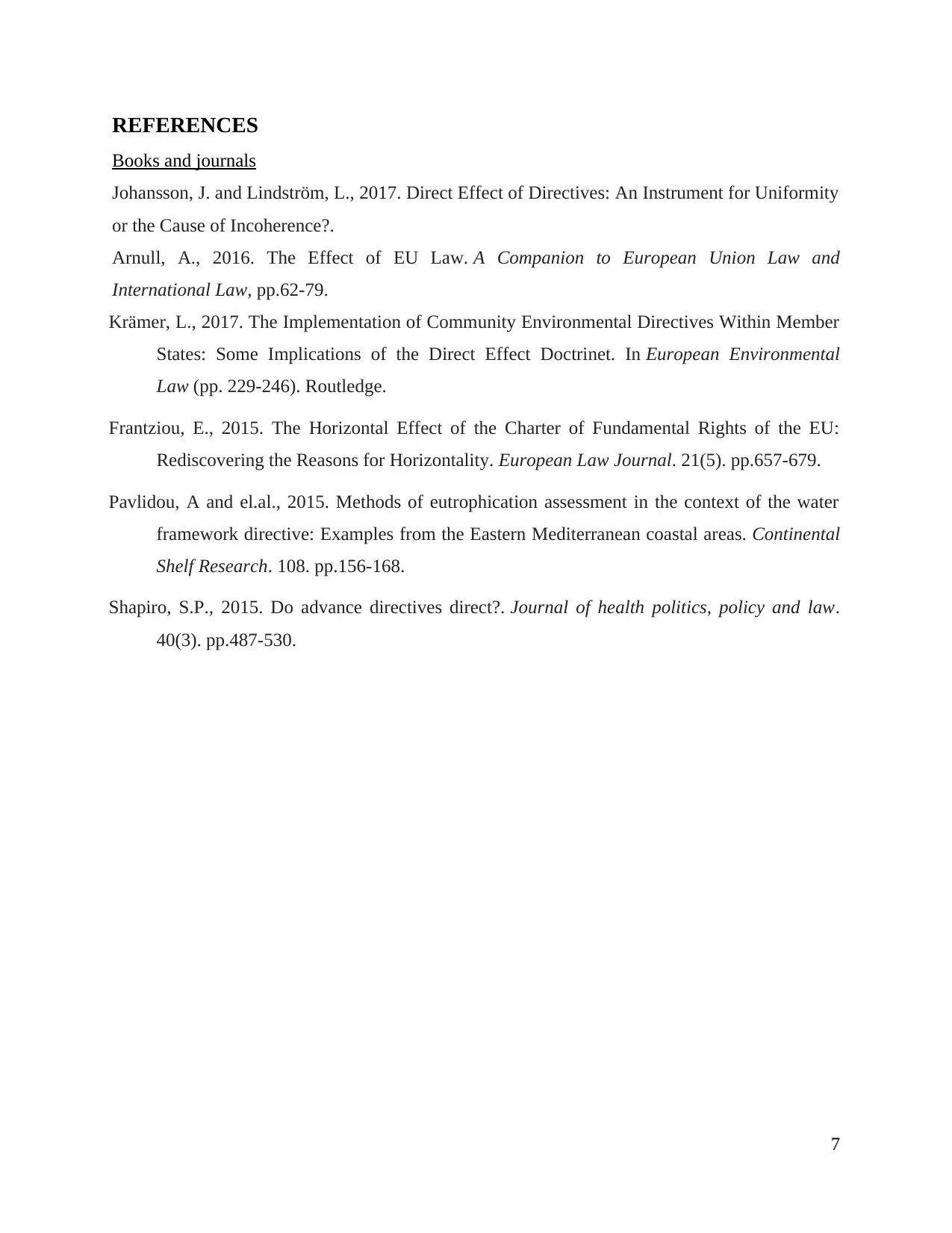
REFERENCES
Books and journals
Johansson, J. and Lindström, L., 2017. Direct Effect of Directives: An Instrument for Uniformity
or the Cause of Incoherence?.
Arnull, A., 2016. The Effect of EU Law. A Companion to European Union Law and
International Law, pp.62-79.
Krämer, L., 2017. The Implementation of Community Environmental Directives Within Member
States: Some Implications of the Direct Effect Doctrinet. In European Environmental
Law (pp. 229-246). Routledge.
Frantziou, E., 2015. The Horizontal Effect of the Charter of Fundamental Rights of the EU:
Rediscovering the Reasons for Horizontality. European Law Journal. 21(5). pp.657-679.
Pavlidou, A and el.al., 2015. Methods of eutrophication assessment in the context of the water
framework directive: Examples from the Eastern Mediterranean coastal areas. Continental
Shelf Research. 108. pp.156-168.
Shapiro, S.P., 2015. Do advance directives direct?. Journal of health politics, policy and law.
40(3). pp.487-530.
7
Books and journals
Johansson, J. and Lindström, L., 2017. Direct Effect of Directives: An Instrument for Uniformity
or the Cause of Incoherence?.
Arnull, A., 2016. The Effect of EU Law. A Companion to European Union Law and
International Law, pp.62-79.
Krämer, L., 2017. The Implementation of Community Environmental Directives Within Member
States: Some Implications of the Direct Effect Doctrinet. In European Environmental
Law (pp. 229-246). Routledge.
Frantziou, E., 2015. The Horizontal Effect of the Charter of Fundamental Rights of the EU:
Rediscovering the Reasons for Horizontality. European Law Journal. 21(5). pp.657-679.
Pavlidou, A and el.al., 2015. Methods of eutrophication assessment in the context of the water
framework directive: Examples from the Eastern Mediterranean coastal areas. Continental
Shelf Research. 108. pp.156-168.
Shapiro, S.P., 2015. Do advance directives direct?. Journal of health politics, policy and law.
40(3). pp.487-530.
7
1 out of 7
Related Documents
Your All-in-One AI-Powered Toolkit for Academic Success.
+13062052269
info@desklib.com
Available 24*7 on WhatsApp / Email
![[object Object]](/_next/static/media/star-bottom.7253800d.svg)
Unlock your academic potential
Copyright © 2020–2025 A2Z Services. All Rights Reserved. Developed and managed by ZUCOL.




